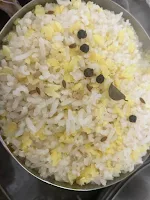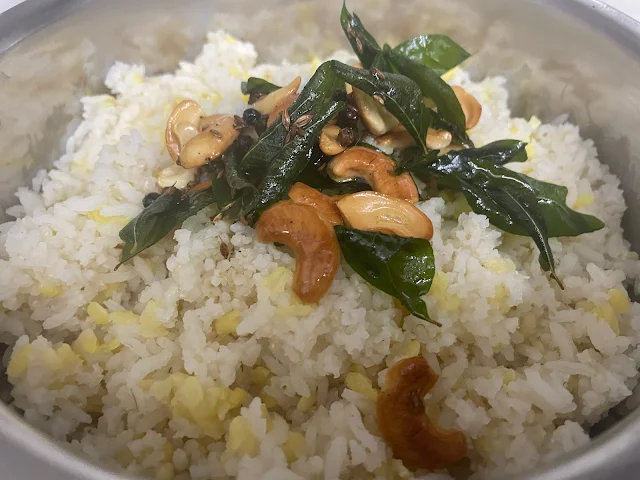Katte Pongal Recipe | How to make Katte Pongali | Easy Katte Pongali Recipe | Katte Pongali Step-by-step | Traditional Katte Pongali | South Indian Katte Pongali | Pongal Recipe | How to make Pongal | Easy Pongal Recipe | Pongal Festival Recipe | South Indian Pongal | Authentic Pongal Recipe | Quick Pongal Recipe | Healthy Pongal Recipe | Vegetarian Pongal Recipe
Recipe: Katte Pongali (Savory Rice and Lentil Dish)
Preparation Time: 10 minutes
Cooking Time: 30 minutes
Total Time: 40 minutes
Servings: 4-6
These timings may vary slightly depending on individual cooking
methods and kitchen efficiency.
1. Introduction:
Katte Pongali is a cherished South Indian delicacy known for its
comforting flavors and wholesome ingredients. This traditional dish holds a special
place in the hearts of many, as it represents the essence of South Indian
cuisine - simple, flavorful, and deeply satisfying. Whether enjoyed during
festive occasions, family gatherings, or as a comforting weekday meal, Katte
Pongali never fails to delight the taste buds and warm the soul.
2. Cultural Significance and History:
- To
truly appreciate Katte Pongali is to delve into its cultural significance
and stored history. In South India, food is not merely sustenance; it is a
way of life, deeply rooted in tradition, community, and spirituality.
Katte Pongali embodies these values, serving as a symbol of prosperity,
unity, and celebration.
- The
origins of Katte Pongali can be traced back centuries, to a tie when rice
and lentils were staple crops cultivated by South Indian Farmers. The dish
emerged as a humble peasant fare, crafted from simple, locally sourced
ingredients and seasoned with aromatic spices. Over time, it evolved into
a beloved culinary tradition, passed down through generations with
reverence and pride.
- Today,
Katte Pongali remains an integral part of South Indian cuisine, enjoyed
during festivals, religious ceremonies, and everyday meals. Its
preparation is steeped in ritual and tradition, with each family adding
its own unique touch to the recipe. From the humblest of homes to the
grandest of feasts, Katte Pongali is a constant presence, bringing people
together in a spirit of camaraderie and joy.
- Katte
Pongali can indeed be offered as Prasad to various gods and goddesses in
Hindu tradition. In many South Indian temples, Katte Pongali is commonly
prepared as an offering during religious ceremonies and festivals.
- The
offering of food to deities, known as Prasad or naivedyam, is an integral
part of Hindu worship. It is believed that by offering food to the gods
with devotion and sincerity, one receives their blessings and grace. The
food offered as Prasad is considered sanctified and is believed to bestow
spiritual merit and purification upon the devotee.
- Katte
Pongali, with its wholesome ingredients and comforting flavors, is often
chosen as Prasad due to its significance in South Indian culture and
cuisine. It symbolizes abundance, prosperity, and nourishment, making it a
fitting offering to the divine.
- When
offering Katte Pongali as Prasad, it is customary to prepare it with
utmost care and devotion, following traditional recipes and rituals. The Prasad
is then placed before the deity as an offering of love and gratitude, and
later distributed among devotees as a sacred blessing.
- Whether
offered in temples or prepared at home for personal worship, Katte Pongali
holds a special place in Hindu religious observance, serving as a tangible
expression of devotion and reverence for the divine.
3. Importance of Ingredients:
The ingredients used in Katte Pongali are simple yet essential,
each contributing to the dish's unique flavor and texture. Rice and moong dal
form the foundation of Katte Pongali, providing a hearty dose of carbohydrates
and re prized for their nutritional value and versatility.
Pepper seeds, cumin seeds, and curry leaves add depth and
complexity to the dish, infusing it with aromatic flavors and earthy
undertones. Ghee, with its rich and buttery texture, enhances the overall taste
of Katte Pongali, giving it a luxurious mouthfeel. Cashews provide a satisfying
crunch, while green chilies offers a subtle heat, balancing the dish's flavors
perfectly.
4. Occasions and Who Can Enjoy It:
Katte Pongali is a versatile dish that can be enjoyed by people of
all ages and backgrounds. It is commonly served during festivals such as
Pongal, Makar Sankranti, and Ugadi, where it symbolizes abundance, prosperity,
and new beginnings. It is also a popular choice for family gatherings,
religious ceremonies, and everyday meals, bringing warmth and comfort to the
dining table.
5. Benefits and Uses of Having This Recipe:
Having this recipe in your culinary repertoire means having access
to a taste of South India's rich culinary heritage. It allows you too recreate
the flavors of home and share them with family and friends, creating memories
that will last a lifetime. Katte Pongali is not only delicious but also
nutritious, providing a balanced meal that is both satisfying and wholesome.
6. Ingredients:
- Rice
- 2 cups
- Moong
Dal - 1 cup
- Pepper
Seeds - 1-2 tsp
- Cumin
Seeds - 1 tsp
- Some
Curry Leaves
- Ghee
- 3 tsp
- Cashews
- 20 g
- Salt,
to taste
- Green
Chilies (Optional) - 2
7. Detailed Cooking Instructions:
1. Rinse the rice and moong dal thoroughly under cold water. In a
large pot, combine the washed rice and dal with 6 cups of water and cook until
tender.
2. In a separate pan, heat ghee over medium heat. Add pepper
seeds, cumin seeds, cashews, curry leaves, and green chilies (if using). Fry
until the cashews are golden brown and fragrant.
3. Once the rice and dal are cooked, add the tempered spices and
ghee to the pot. Mix well to combine.
4. Season Katte Pongali with salt to taste and mix until evenly
distributed.
5. Serve hot, garnished with additional cashews and curry leaves
if desired.
8. Health Benefits and Uses:
Katte Pongali is not just a delicious dish; it is also a
nutritious one, packed with carbohydrates, protein, fiber, and essential
vitamins and minerals. Moong dal is rich in protein and fiber, while rice
serves as an excellent source of energy. Ghee adds healthy fats to the dish,
promoting satiety and aiding in digestion. It provides sustained energy and
promotes overall well-being, making it an ideal choice for anyone looking for a
wholesome and satisfying meal.
9. Cooking Tips and Variations:
- For richer flavor, toast the rice and moong dal before cooking.
- Adjust the amount of spices and green chilies according to
personal preference.
- Substitute ghee with oil for a vegan version.
- For a richer texture, add a splash of coconut milk towards the
end of cooking.
- Substitute cashews with almonds or peanuts for a different
texture and flavor profile.
- Add vegetables such as carrots, peas, or bell peppers for added
nutrition and color.
10. Nutritional Information:
Serving Size: 1 cup
(approximately 200 g)
- Calories: 250
- Protein: 8g
- Fat: 7g
- Carbohydrates: 40g
- Fiber: 5g
- Iron: 2mg
- Calcium: 40mg
11. Presentation and Servings:
- Serve Katte Pongali hot, garnished with fresh cilantro or grated
coconut for added flavor and visual appeal.
- This recipe yields approximately 4 servings, making it ideal for
a family meal or small gathering.
Conclusion:
In conclusion, Katte Pongali is more than just a dish; it is a
celebration of South Indian cuisine and culture. With its simple yet flavorful
ingredients and easy preparation method, it has become a beloved staple in
households across the region. Whether enjoyed during festivals or as a
comforting weekday meal, Katte Pongali brings warmth, flavor, and nourishment
to every plate.












Comments
Post a Comment